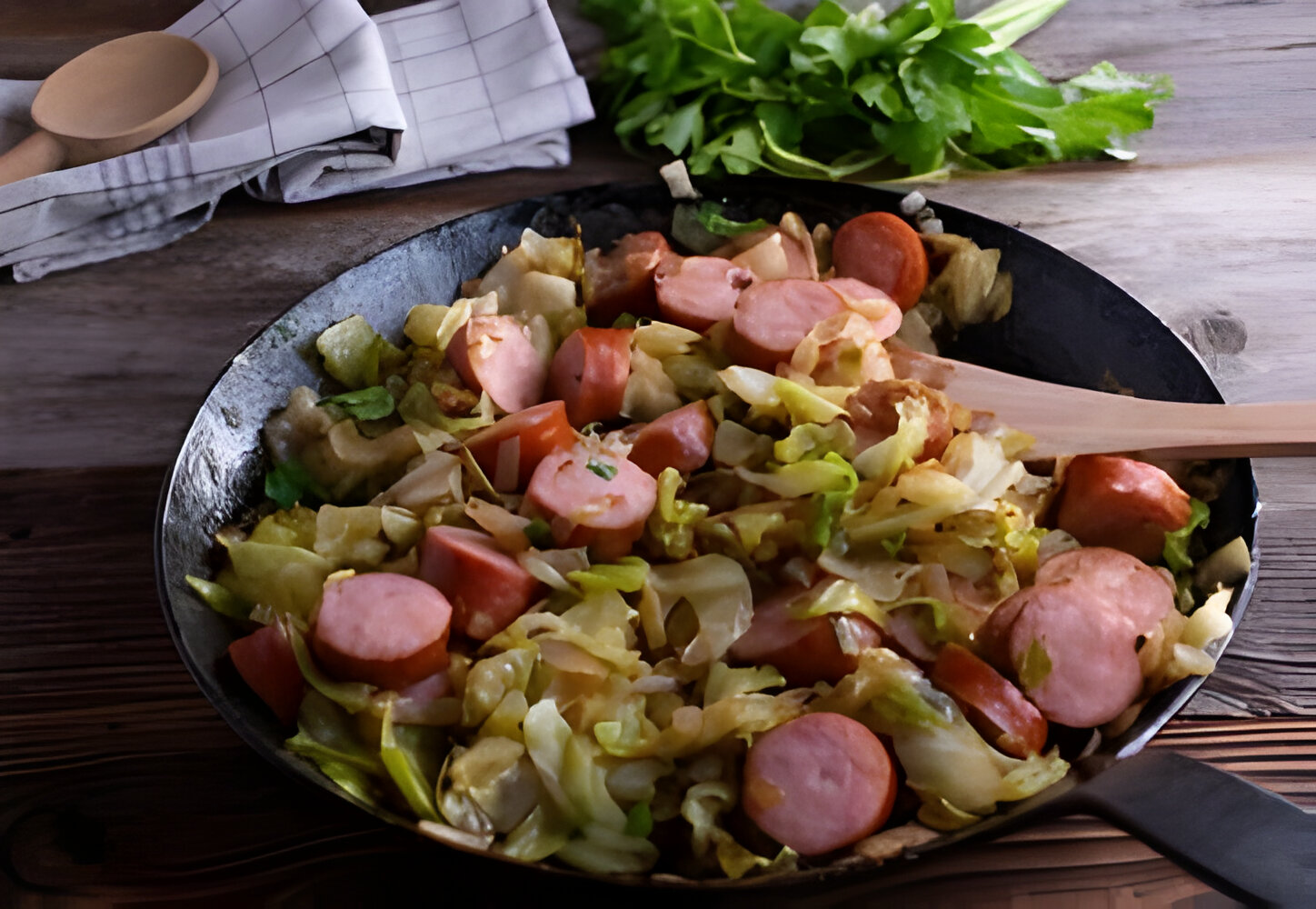The Ultimate Guide to Sautéed Cabbage: A Flavorful and Nutritious Choice
Sautéed cabbage, celebrated for its simplicity and delightful taste, showcases culinary versatility like no other. This comprehensive guide will walk you through the rich history of sautéed cabbage, its numerous health benefits, and the diverse culinary techniques that highlight its best flavors. Consequently, you’ll gain a thorough understanding of this nutritious and flavorful vegetable.
Delving into the Rich Heritage of Sautéed Cabbage
Rooted deeply in both European and Asian culinary traditions, sautéed cabbage has become a dietary staple, celebrated for its nutritional benefits and accessibility. In Europe, it served as essential sustenance during the winter, whereas in Asia, it became a key component in many traditional stir-fry dishes. Therefore, explore the enduring appeal of sautéed cabbage by diving into our collection of time-honored recipes.
Unveiling the Health Benefits of Sautéed Cabbage
Moreover, sautéed cabbage stands out as a nutrition powerhouse, offering a range of health benefits:
- Nutrient-Rich: This leafy green packs essential vitamins C and K, folate, and potassium, all while keeping calories low.
- Fiber Content: Its high fiber content supports digestion, prevents constipation, and promotes fullness.
- Immune Support: Abundant in vitamin C, it strengthens the immune system and fights infections.
- Digestive Health: Known for its detoxifying properties, sautéed cabbage promotes a healthy digestive system.
By incorporating sautéed cabbage into your meals, you’re taking a step toward better health and wellness. Additionally, discover our array of nutritious and delicious recipes to enhance your diet.
Why do you put baking soda in cabbage?
Adding baking soda to cabbage during cooking is a practice some people use for a couple of reasons:
- To Preserve Color: Baking soda can help maintain the vibrant green color of the cabbage. The alkaline nature of baking soda neutralizes the acids present in cabbage, which can cause it to turn an unappealing grayish color when cooked. By preserving the green color, the cabbage may look more appetizing in dishes.
- To Soften Texture: Baking soda can soften the cabbage more quickly by breaking down its fibers. This can be particularly useful if you’re aiming for a very tender texture in a shorter amount of time. However, it’s important to use it sparingly; too much can make the cabbage too mushy.
- To Reduce Gas: Some believe that adding baking soda to cabbage can help reduce the gas-producing effects of the vegetable. Cabbage contains raffinose, a type of sugar that can cause gas and bloating for some people. Baking soda may help to neutralize some of the acids that contribute to gas production during digestion.
Why does cabbage taste sweet when cooked?
Cabbage tastes sweet when cooked due to the breakdown of its complex sugars through a process known as caramelization and, to some extent, the Maillard reaction. Here’s how these processes contribute to the sweetness:
- Caramelization: When cabbage is cooked, especially through methods involving direct heat like sautéing, roasting, or grilling, the heat gradually breaks down the complex carbohydrates (sugars) in cabbage into simpler sugars. As the temperature rises above 150°C (302°F), these sugars begin to caramelize, producing a sweet flavor. Caramelization is a form of non-enzymatic browning that doesn’t involve amino acids but focuses on the sugar itself, enhancing the natural sweetness of the cabbage.
- Maillard Reaction: Although the Maillard reaction is more about browning and flavor development than caramelization, it also contributes to the sweet taste when cooking cabbage. This reaction occurs between amino acids (the building blocks of proteins) and reducing sugars in the cabbage when exposed to heat. It’s responsible for the complex flavors and browned color of cooked foods, including a slight increase in perceived sweetness.
- Breakdown of Glucosinolates: Cabbage contains glucosinolates, sulfur-containing compounds that give raw cabbage its characteristic bitter or peppery taste. Cooking cabbage breaks down these compounds, reducing the bitterness and allowing the natural sweetness to be more prominent.
- Evaporation of Water: Cooking also evaporates water from the cabbage, concentrating its flavors, including its natural sugars, which makes the sweetness more noticeable.
How do you get the gas out of cabbage?
Reducing the gas-producing effects of cabbage involves a few cooking and preparation techniques that can help make it easier to digest and minimize discomfort. Here are some strategies:
- Cooking Method: Cooking cabbage can help break down some of the complex sugars (like raffinose) that cause gas. Steaming, boiling, or stir-frying cabbage can make it easier on the digestive system compared to eating it raw.
- Add Spices: Certain spices are known to aid digestion and can help reduce gas production when added to cabbage dishes. Caraway seeds, fennel seeds, ginger, and turmeric are popular options that not only enhance flavor but also have carminative properties, meaning they help prevent the formation of gas in the gastrointestinal tract.
- Pre-soaking: If you plan to use cabbage raw in a salad, consider pre-soaking the chopped or shredded cabbage in cold water for about 30 minutes. This can help leach out some of the sugars that contribute to gas production. Drain and pat dry before using.
- Fermentation: Fermenting cabbage to make sauerkraut or kimchi can also reduce its gas-producing effects. The fermentation process breaks down the sugars in cabbage into lactic acid, making it easier to digest and adding beneficial probiotics that support gut health.
- Pair with Digestive Aids: Eating cabbage along with foods that are known to aid digestion can help mitigate gas production. Pineapple and papaya, for example, contain natural enzymes (bromelain and papain, respectively) that help break down proteins and complex sugars in the digestive tract.
- Increase Gradually: If your body is not used to digesting cabbage, introduce it into your diet gradually. Starting with small amounts and slowly increasing the serving size can give your digestive system time to adjust.
- Chew Well: Thoroughly chewing cabbage can also reduce gas. Chewing breaks down food into smaller pieces and mixes it with saliva, which contains enzymes that begin the digestion process. This can help ensure that cabbage is more completely digested once it reaches the stomach and intestines.
Can you overcook cabbage?
Yes, you can overcook cabbage. Overcooking cabbage can lead to several undesirable outcomes that affect both its nutritional value and culinary appeal:
- Texture: Overcooked cabbage can become extremely soft and mushy, losing its pleasant crunch and texture. This can make the cabbage less appealing in dishes where a firmer texture is desired.
- Flavor: Cooking cabbage for too long can result in a very strong, sometimes unpleasant sulfur-like smell and taste. This is due to the breakdown of sulfur-containing compounds in the cabbage when exposed to heat for extended periods. The longer cabbage cooks, the more intense these flavors can become.
- Color: Overcooking can also cause cabbage to lose its vibrant color, turning it into a dull grayish-green. This is particularly true for green cabbage, where the appealing bright color is a sign of freshness and proper cooking.
- Nutritional Loss: Prolonged cooking can lead to a significant loss of vitamins and minerals. Cabbage is rich in vitamin C and various B vitamins, which are water-soluble and heat-sensitive. Overcooking, especially in water, can leach these nutrients out of the cabbage, reducing its nutritional value.
To avoid overcooking cabbage, consider the following tips:
- Monitor Cooking Time: Pay close attention to the cooking time and test the cabbage for doneness periodically. Most cabbage dishes require only a few minutes of cooking to retain a crisp texture and bright color.
- Use Appropriate Methods: Steaming or stir-frying cabbage can help preserve its texture, flavor, and nutritional content better than boiling.
- Cook to Preference: Remember that cooking times can vary depending on how you like your cabbage. If you prefer it with a bit of crunch, cook it for a shorter time. If you like it softer, you can cook it a bit longer but be cautious not to let it become mushy.
- Keep it Covered: If you’re steaming or sautéing cabbage, keeping the pan covered can help cook it more evenly and quickly, reducing the risk of overcooking.
By being mindful of cooking times and methods, you can enjoy cabbage that is both nutritious and delicious, without the drawbacks of overcooking.
Exploring Culinary Variations of Sautéed Cabbage
You can prepare sautéed cabbage in many ways, each offering a unique taste. Here are three popular methods:
Classic Sautéed Cabbage
- Ingredients: Cabbage, onion, garlic, butter, seasoning.
- Method: Cook the cabbage gently with onion and garlic in butter until it becomes tender, bringing out its natural sweetness.
Asian-Inspired Sautéed Cabbage
- Ingredients: Cabbage, soy sauce, sesame oil, ginger, garlic.
- Method: Stir-fry to achieve a delightful crunch, making it an ideal side dish or a topping for rice.
Spicy Sautéed Cabbage
- Ingredients: Cabbage, bell peppers, onion, olive oil, spices.
- Method: Add a spicy kick to make it a perfect filling for tacos or wraps.
Mastering the Art of Sautéed Cabbage
To get the best results with sautéed cabbage, consider these tips:
- Firstly, choose fresh, crisp cabbages for the best taste and texture.
- Secondly, slice the cabbage thinly to ensure even cooking and flavor distribution.
- Finally, adjust your cooking technique to suit the recipe for the perfect outcome.
Offering Versatile Serving Suggestions for Sautéed Cabbage
This versatile dish pairs well with various meals:
- Serve it alongside grilled or roasted proteins for a balanced dish.
- Alternatively, turn it into a hearty main course by adding meats or plant-based proteins.
- Lastly, get creative with leftovers in breakfast dishes or as sandwich fillings.
Addressing FAQs About Sautéed Cabbage
- Choosing the Best Cabbage: Firm, vibrant green cabbage works best for sautéing.
- Preparing in Advance: You can make it ahead and reheat it without losing its charm.
- Enhancing the Flavor: Spice it up with different herbs, spices, and fats.
- Nutritional Profile: Sautéed cabbage remains a healthy option when prepared with minimal fats.
For another enticing side dish, check out our guide to crispy air fryer roast potatoes, which complements sautéed cabbage beautifully.
In conclusion, sautéed cabbage is more than just a dish; it’s a journey through culinary history, culture, and nutrition. Whether you love the traditional version, a spicy twist, or an Asian-inspired flavor, sautéed cabbage promises to enhance your meals with both taste and health benefits. Embark on the culinary adventure of sautéed cabbage and unleash your kitchen creativity.

